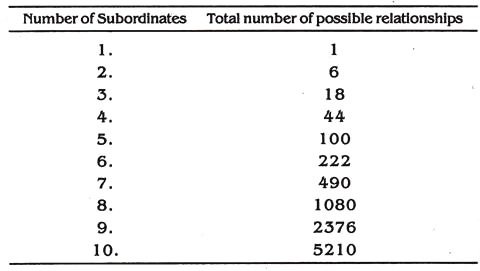After reading this article you will learn about the relationship between the superior and subordinate according to V.A. Graicunas
V.A. Graicunas was a French management consultant, lie developed a mathematical formula by analysing superior- subordinate relationships. He suggests that as the number of subordinates increases arithmetically there is exponential increase in the number of possible relationships.
Graicunas has identified three types of superior- subordinates relationships:
1. Direct Single Relationships:
The direct single relationship arises from the direct and individual contact of the superior with his subordinates. For example, if a manager A has two subordinates X and Y there would be two direct single relationships.
2. Direct Group Relationships:
These relationships arise between the manager and group of his subordinates in all possible combinations.
Thus in the above example there would be two direct group relationships:
(a) A with X, Y in attendance.
(b) A with Y, X in attendance.
3. Cross-Relationships:
These relationships arise among the subordinates working under a common superior.
In the above example there would be two cross- relationships:
(a) X with Y and (b) Y with X.
Thus, direct relationships = n
= n (2n-1 -1)
Cross relationships = n (n-1)
Total relationships = n[![]() +n-1]=n(2n-1+n-1)
+n-1]=n(2n-1+n-1)
Where n = number of subordinates.
Hence, he has established that for 2, 3 and 4 subordinates the number of total relationships would be 6,18 and 44 respectively.
Applying the formula for 4 subordinates
Total relationships = 4(24-1+4-1)
= 4(23+4-1)
= 4(8 + 4-1)
= 4.11
= 44.
Graicunas suggested that an executive can effectively manage 222 relationships, which arise out of 6 subordinates. His formula is helpful in finding out the number of relationships. It gives an important indication that an executive must think before increasing his span because every increase in one subordinate will lead to manifold increase in relationships.
However, his approach suffers from several shortcomings. Firstly, it ignores the intensity of their relationships and importance. Secondly, he left out certain possible relationships, particularly in cross-relationships.
Thirdly, he failed to identify the factors which govern the span of management such as nature of work type of technology, ability of the manager, capacity of subordinates, degree of decentralisation, planning, staff assistance, communication techniques and time available for supervision.
Anyway his mathematical formula has given us an idea of the different types of superior-subordinate relationships, which is very helpful in determining the span of control.
Based on the above analysis, the number of possible relationships can be shown in the form of table.
